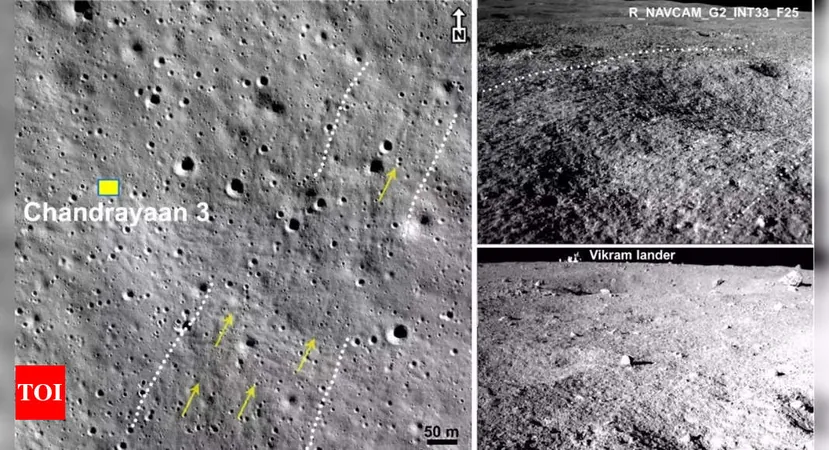
Chandrayaan-3 Lands in Ancient Lunar Crater, Revealing Secrets of the Moon's History
2024-10-01
Author: Ying
Chandrayaan-3 Lands in Ancient Lunar Crater
In a groundbreaking announcement from the Indian Space Research Organisation (ISRO), scientists have confirmed that India’s Chandrayaan-3 mission successfully landed within one of the Moon's oldest and most significant buried impact craters. This extraordinary find deepens our understanding of lunar geology as experts believe the crater, measuring approximately 160 km in diameter and 4.4 km deep, predates the well-known South Pole-Aitken (SPA) basin.
Exploration by Vikram and Pragyan
The Chandrayaan-3 lander, named Vikram, along with its rover, Pragyan, are exploring this ancient crater, which is believed to contain ejecta material from the SPA basin as well as some of the Moon’s most profoundly excavated materials. Ejecta refers to the debris ejected during explosive lunar events, such as volcanic eruptions or meteor impacts, making this discovery particularly exciting for scientists studying the Moon's geological history.
Data and Research Behind the Discovery
The data underpinning this discovery was gathered through high-resolution imagery from both the Chandrayaan-3 rover and the Chandrayaan-2 orbiter's navigation cameras. The research, led by a team of scientists and published in the peer-reviewed journal "Icarus," highlights the sophistication of India’s space exploration endeavors regarding its meticulous planning and execution.
Geological Insights and Findings
The study revealed that Chandrayaan-3 is situated around 350 km from the rim of the SPA basin, the largest and most ancient impact basin in our Solar System. The complexity of the landing site has resulted from the interplay of various ejecta materials from the SPA and other surrounding basins, suggesting a rich geological history.
ISRO's Remarkable Findings
ISRO elaborated that nearly 1,400 meters of material can be attributed to the SPA basin, with an additional 580 meters of ejecta provided by eleven other nearby craters. Even smaller complex craters in the vicinity contributed crucial insights, as their ejecta is vital for ongoing in-situ analyses conducted by the Pragyan rover.
Unique Features Around the Landing Site
Scientific investigation has uncovered intriguing features around the landing site. Images from the rover's navigation cameras indicated the existence of unique linear structures—groove-like formations that may have been shaped by distant impacts. These findings provide important clues about the Moon’s violent past and its surface transformation over billions of years.
Significance of Regional Exploration
Furthermore, the regional exploration has unearthed a semi-circular feature, albeit heavily eroded, suggesting the presence of a significant impact structure. Experts now view this as a composite of various lunar geological processes.
Conclusion and Future Implications
As scientists continue their work, this mission not only enhances our knowledge of the Moon but also positions India as a leader in space exploration, capable of making major contributions to our understanding of planetary sciences. The insights gained from Chandrayaan-3 could reshape lunar studies and possibly inform future missions related to human habitation and resource exploitation on our nearest celestial neighbor.
Stay Tuned
Stay tuned for more updates as this exciting mission unfolds!


 Brasil (PT)
Brasil (PT)
 Canada (EN)
Canada (EN)
 Chile (ES)
Chile (ES)
 España (ES)
España (ES)
 France (FR)
France (FR)
 Hong Kong (EN)
Hong Kong (EN)
 Italia (IT)
Italia (IT)
 日本 (JA)
日本 (JA)
 Magyarország (HU)
Magyarország (HU)
 Norge (NO)
Norge (NO)
 Polska (PL)
Polska (PL)
 Schweiz (DE)
Schweiz (DE)
 Singapore (EN)
Singapore (EN)
 Sverige (SV)
Sverige (SV)
 Suomi (FI)
Suomi (FI)
 Türkiye (TR)
Türkiye (TR)